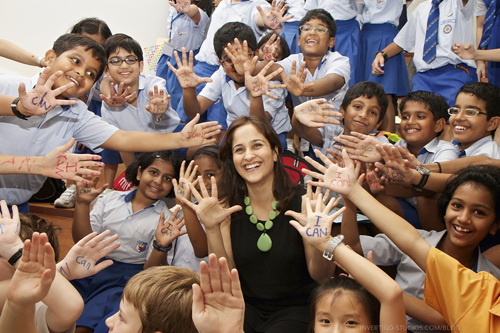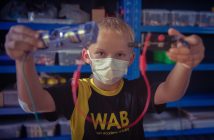Kiran Bir Sethi says that for children to succeed, they need to learn the value of two simple words: I can. Sethi was recently named a 2015 Asia Game Changer award recipient for her work empowering children in education. Her TED Talk explaining her theory and program has been viewed over 1.2 million times. She is the founder and director of the renowned Riverside School in Ahmedabad, India, which features Multiple Intelligences theory in its planning, instruction, and assessment at the primary level, and uses a unique design-focused framework based on her innovative ‘I can’ teaching model.
Drawing on her background in visual communications, in 2009 Sethi founded Design for Change, now a global movement inspiring children to – in the words of Gandhi – “be the change they wish to see in the world.” With partners in 35 countries in over 200,000 schools worldwide, the project helps children decide on an issue that bothers them – usually a school or community issue – and find ways to transform the situation. Their stories are shared on Design for Change’s website and used as a reference and resource bank to inspire and support other children around the world as they attempt their own change-making projects. Children’s stories range from very basic – such as cleaning bathrooms or solving the problem of heavy school bags – to more complex issues like alcohol and drug abuse, child labor, and child marriage.
Under the theme, “A Superhero in Every Child,” Sethi recently visited Daystar Academy and spoke at Ivy Schools Distinguished Speaker Series in an event open to educators and parents of the Beijing community. We had the chance to sit down with Sethi and learn more about her viral venture taking the education world by storm.
How is design thinking used in a classroom context?
Design thinking is a framework that gets children thinking they are not helpless, that change is possible and they can drive it. Any child, anywhere in the world, can make the world a better place. It’s human-centered. It’s the fact that all education and every human endeavor should start with empathy. Who is this user? How does this child learn? Who is this child? So much of the focus in education has been on results that we forget there is a child. It’s not about changing systems but more about changing the child themselves.
How was Design for Change conceptualized?
Eight years after we started The Riverside School, kids were developing this tremendous creative confidence. Confidence that they didn’t need to have the answer and that if they followed a certain process, that they would be able to effect change. We said there’s clearly something making a big difference here. We wondered how we could take it beyond Riverside and Design for Change really became that conversation with the world.
Until then, design and design thinking was [utlized]only in Silicon Valley or in colleges. We just had to remove the jargon and demystify it. We said, ‘there are four simple steps: Feel, Imagine, Do, and Share. If children can do it, then anyone can.’ We put these four steps into a tool kit, translated the information to 15 languages, and gave it to 30,000 schools in India. It took off.

Can you explain how the Feel, Imagine, Do, Share model works in function? (See previous page)
I’ll give you the example of garbage because so many schools and children say they clean up garbage. What happens is that the teacher will take them to a garbage dump outside, they clean it up and a week later, it’s back. What they’ve forgotten is that garbage is not the problem; it’s people who deposit garbage that are a problem. The first step, ‘Feel’ is when you observe human pattern and pause. You can look at who’s associated with the situation. Who are the people that collect it? Who’s affected by it? I view a situation and I look at the opportunities for change. Observe who is interacting with this situation and then, interact with the people involved. Two simple steps under ‘Feel’: observe and engage.
The second step is ‘Imagine.’ What is the preferred step? What do you want to create from this? What do you want to give? Maybe you can say, ‘I want to beautify this area’ or ‘for this area or to become a place for compost.’ So suddenly, the nature of ‘Imagine’ is not only that the garbage is clear, but you’re asking how you can design a situation where this can not only become a collection site, but how to turn it into compost.
The ‘Do’ is the action. I go ahead and make sure that happens. And ‘Share’ is sharing your story of change online.
When we give this to schools, we ask students what bothers them. And then we’ll show some of the other children’s stories. Children are raising funds for a school trips, building fences, and doing street plays. I show simple stories; they decide.
What has the impact been like?
The last step, ‘Share’ is probably our greatest step. Children can see that you don’t have to be rich or strong or 18 years old to make change happen. The greatest impacts are on the children themselves. When they present a story of change, you can see confidence. When I had the opportunity to speak on TED, I had no idea this would resonate like it has. This idea of ‘I can’ was a missing piece that educators were looking for. People from across the world started calling me. We said, ‘please take it to your country and get every child to believe that they can.’
Design for Change is currently being used in two different ways. What’s the distinction?
One is the one-week challenge. The call to action is take one idea, choose one week, and change a billion lives; that’s the open challenge. It’s easy to implement because it’s extremely flexible. The school can decide how long, how often, and how many times they want to do it. It could be done during a character values period, a 21st century skills curriculum, or a lot of schools around the world with an IB curriculum choose to take Design for Change during the CAS (Creativity, Action, Service) programme.
The second way we do Design for Change is a year-long curriculum. Many schools were saying they loved the one-week challenge but wanted to take it deeper. We worked with Dr. Howard Gardner’s Multiple Intelligences team at Harvard to create the first design-thinking subject into to a curriculum for children. Right now, we just have a Year 8 prototype because a lot of our research says that 13 year-olds are your greatest change makers because they’re the most confident and are not yet weighed down by exams. We’re currently piloting it in India in about 60 schools. Once we see the efficacy of it, we’ll present it to education policy makers. We’re in the process of designing for Grades 3-7 at the moment.
In what ways does the curriculum nurture this ‘I can’ mindset?
The framework says that when I take responsibility for my actions, then ‘I can.’ There are a lot of schools built on this ‘teacher told me to do it’ attitude. If I say that, then I don’t know why I’m doing it. But when I take the responsibility after the ‘Feel’ and ‘Imagine,’ then I know what I’m doing is making this this ‘Imagine’ come alive. That’s that shift from I can’t to I can.
How do educators doing a Design for Change project support children’s learning?
I think educators are so used to telling and instructing that we don’t listen enough. What design thinking and the ‘Feel’ says is, I’m not going to tell you what bothers you, I’m going to listen.
Can parents get involved?
We’ve had parents do this as a birthday party project. Rather than receiving a gift, kids are giving a gift of change. Kids feel fantastic. This is a super way parents can be part of it. But parents should listen; don’t force the idea. I think parents do not parent with enough courage. With so much focus and entitlement, it leads to the belief that our children are helpless. One of the greatest gifts we can give them is optimism and the belief that I am not entitled.
What stories of change do you find most concerning?
Bullying is a big issue. What’s coming out are a couple of things: One is that our schools are not designed for safety. Four areas have come out as maximum areas of bullying: the courtyard, bathrooms, buses, and playgrounds. Data in terms of education and policy is very important. If our children aren’t emotionally safe – no matter what we teach them – it doesn’t register. And that we must take very seriously.
Resources
Get Involved
Interested in bringing the Design for Change Open Challenge or curriculum to your home or school? The online tool kit is available to download. Select by country or language. Visit
dfc.world.com to find out more and view stories of change.
This article originally appeared on page 42-44 of the beijingkids October 2015 issue. Click here to read the issue for free on Issuu.com. To find out how you can get your own copy, email distribution@truerun.com.





1 Comment
Pingback: Asia Game-Changer Award Recipient on her Award Winning Project – Yvette Ferrari